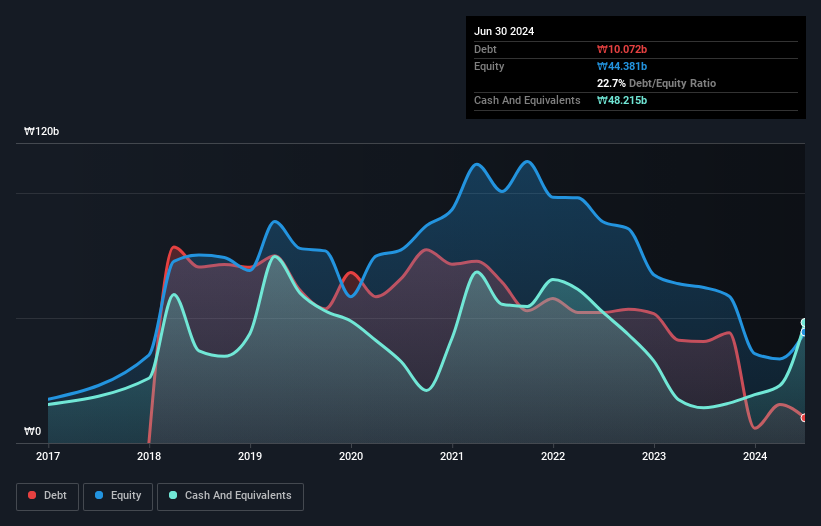- South Korea
- /
- Biotech
- /
- KOSDAQ:A142760
Health Check: How Prudently Does MOA Life Plus (KOSDAQ:142760) Use Debt?

The external fund manager backed by Berkshire Hathaway's Charlie Munger, Li Lu, makes no bones about it when he says 'The biggest investment risk is not the volatility of prices, but whether you will suffer a permanent loss of capital.' So it seems the smart money knows that debt - which is usually involved in bankruptcies - is a very important factor, when you assess how risky a company is. As with many other companies MOA Life Plus Co. Ltd. (KOSDAQ:142760) makes use of debt. But the real question is whether this debt is making the company risky.
What Risk Does Debt Bring?
Debt and other liabilities become risky for a business when it cannot easily fulfill those obligations, either with free cash flow or by raising capital at an attractive price. Ultimately, if the company can't fulfill its legal obligations to repay debt, shareholders could walk away with nothing. While that is not too common, we often do see indebted companies permanently diluting shareholders because lenders force them to raise capital at a distressed price. Of course, debt can be an important tool in businesses, particularly capital heavy businesses. The first thing to do when considering how much debt a business uses is to look at its cash and debt together.
See our latest analysis for MOA Life Plus
What Is MOA Life Plus's Debt?
As you can see below, MOA Life Plus had ₩10.1b of debt at June 2024, down from ₩40.6b a year prior. However, its balance sheet shows it holds ₩48.2b in cash, so it actually has ₩38.1b net cash.

A Look At MOA Life Plus' Liabilities
The latest balance sheet data shows that MOA Life Plus had liabilities of ₩19.2b due within a year, and liabilities of ₩448.3m falling due after that. Offsetting this, it had ₩48.2b in cash and ₩7.41b in receivables that were due within 12 months. So it actually has ₩36.0b more liquid assets than total liabilities.
This excess liquidity is a great indication that MOA Life Plus' balance sheet is almost as strong as Fort Knox. With this in mind one could posit that its balance sheet means the company is able to handle some adversity. Simply put, the fact that MOA Life Plus has more cash than debt is arguably a good indication that it can manage its debt safely. There's no doubt that we learn most about debt from the balance sheet. But you can't view debt in total isolation; since MOA Life Plus will need earnings to service that debt. So when considering debt, it's definitely worth looking at the earnings trend. Click here for an interactive snapshot.
While it hasn't made a profit, at least MOA Life Plus booked its first revenue as a publicly listed company, in the last twelve months.
So How Risky Is MOA Life Plus?
We have no doubt that loss making companies are, in general, riskier than profitable ones. And in the last year MOA Life Plus had an earnings before interest and tax (EBIT) loss, truth be told. And over the same period it saw negative free cash outflow of ₩257m and booked a ₩12b accounting loss. But the saving grace is the ₩38.1b on the balance sheet. That means it could keep spending at its current rate for more than two years. Overall, its balance sheet doesn't seem overly risky, at the moment, but we're always cautious until we see the positive free cash flow. There's no doubt that we learn most about debt from the balance sheet. But ultimately, every company can contain risks that exist outside of the balance sheet. Be aware that MOA Life Plus is showing 2 warning signs in our investment analysis , you should know about...
Of course, if you're the type of investor who prefers buying stocks without the burden of debt, then don't hesitate to discover our exclusive list of net cash growth stocks, today.
If you're looking to trade MOA Life Plus, open an account with the lowest-cost platform trusted by professionals, Interactive Brokers.
With clients in over 200 countries and territories, and access to 160 markets, IBKR lets you trade stocks, options, futures, forex, bonds and funds from a single integrated account.
Enjoy no hidden fees, no account minimums, and FX conversion rates as low as 0.03%, far better than what most brokers offer.
Sponsored ContentNew: Manage All Your Stock Portfolios in One Place
We've created the ultimate portfolio companion for stock investors, and it's free.
• Connect an unlimited number of Portfolios and see your total in one currency
• Be alerted to new Warning Signs or Risks via email or mobile
• Track the Fair Value of your stocks
Have feedback on this article? Concerned about the content? Get in touch with us directly. Alternatively, email editorial-team (at) simplywallst.com.
This article by Simply Wall St is general in nature. We provide commentary based on historical data and analyst forecasts only using an unbiased methodology and our articles are not intended to be financial advice. It does not constitute a recommendation to buy or sell any stock, and does not take account of your objectives, or your financial situation. We aim to bring you long-term focused analysis driven by fundamental data. Note that our analysis may not factor in the latest price-sensitive company announcements or qualitative material. Simply Wall St has no position in any stocks mentioned.
About KOSDAQ:A142760
MOA Life Plus
Engages in the medicine and consumer business in South Korea.
Flawless balance sheet and slightly overvalued.
Market Insights
Community Narratives



